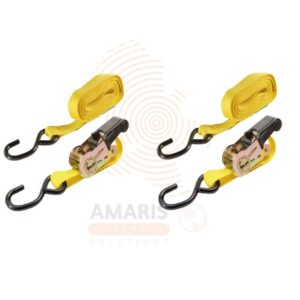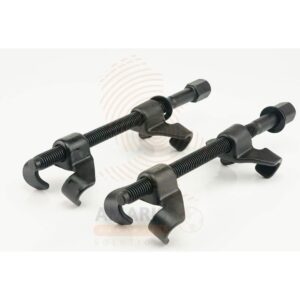Flat Webbing Slings 2Tx1M (12pieces)
Whatsapp Order
A flat webbing sling for hardware use is a robust and flexible lifting or securing tool designed for use in hardware and industrial applications. Constructed from durable materials such as polyester or nylon, this sling takes the form of a flat, wide strip. It is specifically engineered to handle heavy loads and is equipped with reinforced stitching and sturdy hardware attachments, such as metal eyelets or hooks, to facilitate safe and efficient lifting, rigging, or hoisting tasks. Flat webbing slings for hardware use are integral components in various industries, providing a reliable and adaptable solution for the handling of equipment, machinery, or other heavy items.
1. High-strength polyester
2. Extension rate less then 7%
3. Packed by shrink bag
KSh 9,140.00 KSh 9,640.00
Flat Webbing Slings Uses
- Material Handling and Lifting: Flat webbing slings are commonly used for lifting and handling loads in warehouses, manufacturing plants, and construction sites. They are suitable for hoisting heavy equipment, machinery, and materials.
- Construction Sites: In the construction industry, flat webbing slings are utilized for lifting and positioning steel beams, concrete panels, and other construction materials. Their flexibility and strength make them valuable in various construction applications.
- Rigging and Rigging Operations: Flat webbing slings are integral components in rigging operations. They are used to secure and lift loads during rigging activities in industries such as oil and gas, shipping, and offshore operations.
- Transportation and Logistics: These slings are employed for securing loads during transportation. Whether it’s securing cargo on trucks, trailers, or ships, flat webbing slings play a crucial role in preventing shifting or damage during transit.
- Maintenance and Repairs: When performing maintenance or repairs on machinery and equipment, flat webbing slings are useful for lifting and supporting components. They allow for controlled and precise positioning of heavy parts.
- Utilities and Power Generation: In the utilities sector, such as power plants, flat webbing slings are utilized for lifting and installing equipment like generators, transformers, and other heavy components.
- Tree and Pole Removal: Arborists and utility workers often use flat webbing slings to lift and lower sections of trees or utility poles safely.
- Marine and Offshore Applications: In maritime and offshore industries, flat webbing slings are employed for lifting and handling equipment on ships, oil platforms, and other offshore structures.
- Rescue Operations: Flat webbing slings can be adapted for use in rescue scenarios where controlled lifting and positioning are required, such as during emergency response operations.
- Agriculture: In agricultural settings, flat webbing slings may be used for lifting and handling equipment, machinery, or even in unique applications like assisting in the removal of heavy crops.
Size
2T x 1M, 2T x 3M
Safety measures and precautions
- Inspect Regularly: Before each use, inspect the flat webbing sling for any signs of damage, wear, or abrasion. Check for cuts, fraying, or distortions in the webbing. If any defects are found, replace the sling immediately.
- Follow Load Limits: Adhere to the safe working load (SWL) specified by the manufacturer. Overloading a sling can lead to failure and accidents. Consider the weight of the load, and choose a sling with an appropriate SWL.
- Use Proper Attachments: Ensure that the flat webbing sling is securely attached to the lifting points on the load. Use suitable hooks, shackles, or other approved attachments. Confirm that the attachments are in good condition and have the required load rating.
- Protect Against Abrasion: Avoid dragging the sling over rough or abrasive surfaces. This can cause abrasion and weaken the webbing. Use protective sleeves or padding if necessary.
- Control Load Movement: Prevent the load from swinging or rotating during lifting. Use tag lines or other control measures to stabilize the load and maintain control over the lifting operation.
- Avoid Twisting: Ensure that the sling is not twisted or knotted before lifting. Twisting can reduce the strength of the sling and compromise its integrity.
- Use Proper Lifting Techniques: Train personnel on proper lifting techniques, including the correct angles for attachment points and the use of tag lines for control. Avoid sudden movements or jerks during lifting.
- Protect Against Chemicals: Be aware of the chemicals and environmental conditions in the lifting area. Some chemicals or exposure to UV radiation may degrade the sling material. Choose slings that are resistant to the specific conditions in the work environment.
- Consider Environmental Factors: Be mindful of weather conditions such as wind, rain, or extreme temperatures. Adverse weather can affect the lifting operation, and additional precautions may be necessary.
- Implement a Rigging Plan: Before lifting, develop a comprehensive rigging plan that considers load weight, sling configuration, and attachment points. Communicate the plan to all involved personnel.
- Training and Certification: Ensure that personnel involved in the use of flat webbing slings are trained and certified in safe lifting practices. This includes knowledge of equipment use, inspection procedures, and emergency response.
- Emergency Preparedness: Have a clear plan for responding to emergencies, including the prompt evacuation of the area if necessary. Ensure that personnel are familiar with emergency procedures and equipment.






Westin –
Pleasantly surprised by the affordability.
Westin –
Steve Mbogo –
Great deal for the quality
Steve Mbogo –
Koleen Diaz –
Worth every penny.
Koleen Diaz –